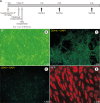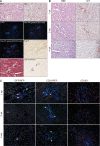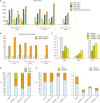Hepatocyte and mesenchymal stem cell co-transplantation in rats with acute liver failure
- PMID: 35769351
- PMCID: PMC9187042
- DOI: 10.4285/kjt.2020.34.2.100
Hepatocyte and mesenchymal stem cell co-transplantation in rats with acute liver failure
Abstract
Background: Cell therapy is considered a potential alternative to liver transplantation in acute liver failure (ALF). We aimed to evaluate the add-on therapeutic benefit of hepatocyte and mesenchymal stem cell (MSC) cotransplantation over hepatocyte-only transplantations in a rat model of ALF.
Methods: ALF was induced by D-galactosamine in Sprague-Dawley rats. Freshly isolated donor hepatocytes were derived from Tg (UBC-emGFP) rats and MSCs were collected from the bone marrow cells of DsRed rats. Donor hepatocytes (1×107/mL) were intraportally transplanted 24 hours after treatment with D-galactosamine over a 70-second interval, and donor MSCs (0.5, 1, or 2×106/0.5 mL) were intraportally transplanted 1 hour after the hepatocyte transplantation was complete. Animals were sacrificed after 7 and 14 days and subjected to donor cell identification, liver histology, serologic testing, and immunohistopathological examination.
Results: MSCs were observed in the periportal area, 1 and 2 weeks after transplantation. Transplanted hepatocytes did not actively proliferate when compared to hepatocyte-only transplantation. Morphologically, transplanted MSCs did not appear to differentiate into hepatocytes even 2 weeks after transplantation. Cotransplantation of MSCs was associated with lower macrophage infiltration, and reduced type I collagen, hepatocyte growth factor, tumor necrosis factor-α, and interleukin 10 expression, with similar gene expression profiles for epidermal growth factor and interleukin 6, when compared to hepatocyte-only transplantation.
Conclusions: Hepatocyte and MSC cotransplantation is feasible and safe in rat models of ALF. MSCs were found to survive the process and could be located within the periportal niches 2 weeks after treatment, without enhancing transplanted hepatocyte proliferation or differentiating into hepatocytes, while ameliorating the inflammatory response.
Keywords: Acute liver failure; Cell transplantation; Mesenchymal stem cells.
© 2020 The Korean Society for Transplantation.
Figures



Similar articles
-
Mesenchymal stem cells increase heme oxygenase 1-activated autophagy in treatment of acute liver failure.Biochem Biophys Res Commun. 2019 Jan 15;508(3):682-689. doi: 10.1016/j.bbrc.2018.11.146. Epub 2018 Dec 5. Biochem Biophys Res Commun. 2019. PMID: 30528392
-
Coencapsulation of hepatocytes with bone marrow mesenchymal stem cells improves hepatocyte-specific functions.Transplantation. 2009 Nov 27;88(10):1178-85. doi: 10.1097/TP.0b013e3181bc288b. Transplantation. 2009. PMID: 19935371
-
Transplantation of human stem cell-derived hepatocytes in an animal model of acute liver failure.Surgery. 2015 Aug;158(2):349-59. doi: 10.1016/j.surg.2015.04.014. Epub 2015 May 29. Surgery. 2015. PMID: 26032830
-
Mesenchymal stromal cells (MSCs) and their exosome in acute liver failure (ALF): a comprehensive review.Stem Cell Res Ther. 2022 May 8;13(1):192. doi: 10.1186/s13287-022-02825-z. Stem Cell Res Ther. 2022. PMID: 35527304 Free PMC article. Review.
-
Mesenchymal Stem Cell Therapy in Acute Liver Failure.Gut Liver. 2023 Sep 15;17(5):674-683. doi: 10.5009/gnl220417. Epub 2023 Feb 27. Gut Liver. 2023. PMID: 36843422 Free PMC article. Review.
Cited by
-
Epigenetic modulation inhibits epithelial-mesenchymal transition-driven fibrogenesis and enhances characteristics of chemically-derived hepatic progenitors.Ann Surg Treat Res. 2024 May;106(5):274-283. doi: 10.4174/astr.2024.106.5.274. Epub 2024 Apr 30. Ann Surg Treat Res. 2024. PMID: 38725803 Free PMC article.
References
LinkOut - more resources
Full Text Sources
Miscellaneous

